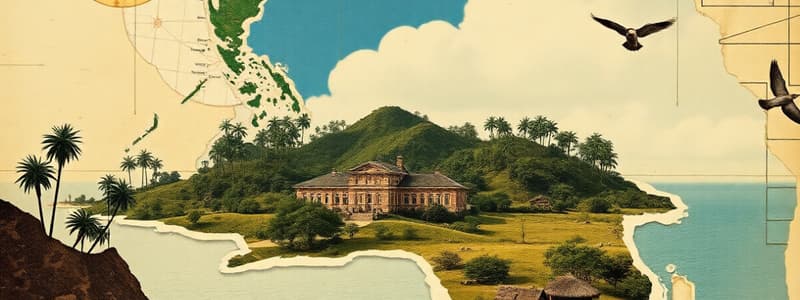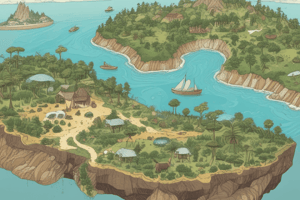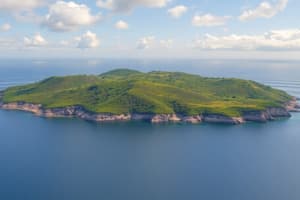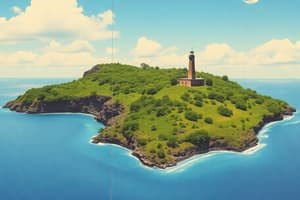Podcast
Questions and Answers
How did the Pleistocene era impact the major islands of the Philippines?
How did the Pleistocene era impact the major islands of the Philippines?
The Pleistocene era caused glacier meltdown, which disconnected the major islands of the Philippines.
What are the five major Pleistocene island groups that became prominent during repeated glacial events in the Philippines?
What are the five major Pleistocene island groups that became prominent during repeated glacial events in the Philippines?
Greater Luzon, greater Mindanao, Panay, greater Sulu, and greater Palawan.
What is unique about the species found on each of the Pleistocene islands of the Philippines?
What is unique about the species found on each of the Pleistocene islands of the Philippines?
Each island harbors unique species.
What percentage of non-flying mammals in greater Luzon do not exist elsewhere?
What percentage of non-flying mammals in greater Luzon do not exist elsewhere?
According to evolutionary theory, how are newly formed geographically isolated islands populated?
According to evolutionary theory, how are newly formed geographically isolated islands populated?
What process occurs after populations from the mainland adapt to the new environment on isolated islands?
What process occurs after populations from the mainland adapt to the new environment on isolated islands?
What do migration events from island to island within an archipelago lead to?
What do migration events from island to island within an archipelago lead to?
What patterns are chiefly apparent on islands due to adaptation of species in response to new environments?
What patterns are chiefly apparent on islands due to adaptation of species in response to new environments?
What best explains the general geographic pattern of distribution of species on islands?
What best explains the general geographic pattern of distribution of species on islands?
What is homology?
What is homology?
How does the environment of an island typically compare to that of the nearest mainland, even if the species are closely related?
How does the environment of an island typically compare to that of the nearest mainland, even if the species are closely related?
What makes biotic similarities of certain island groups in the Philippines only make sense?
What makes biotic similarities of certain island groups in the Philippines only make sense?
How does the formation of novel species on islands relate to the ancestral population?
How does the formation of novel species on islands relate to the ancestral population?
How do isolated islands become occupied according to the evolutionary theory?
How do isolated islands become occupied according to the evolutionary theory?
What role does the Philippines play in the context of island biodiversity?
What role does the Philippines play in the context of island biodiversity?
How do patterns of divergence from ancestral populations manifest on islands?
How do patterns of divergence from ancestral populations manifest on islands?
In the context of evolutionary adaptation and speciation, what is the significance of habitat migrations on islands?
In the context of evolutionary adaptation and speciation, what is the significance of habitat migrations on islands?
What does the uniqueness of species on the Pleistocene islands of the Philippines indicate in terms of evolutionary history?
What does the uniqueness of species on the Pleistocene islands of the Philippines indicate in terms of evolutionary history?
What broader scientific principle is supported by evidence from comparative anatomy, specifically the concept of homology?
What broader scientific principle is supported by evidence from comparative anatomy, specifically the concept of homology?
How might repetitive migration events on an island impact the evolution of species present on that island?
How might repetitive migration events on an island impact the evolution of species present on that island?
Flashcards
Island Species
Island Species
Islands inhabited by species closely related to those on the nearest mainland.
Homology
Homology
An alternative piece of evidence that supports evolution, is defined as any anatomical feature originally possessed by an ancestor that has subsequently been modified by its descendants.
General geographic pattern
General geographic pattern
The patterns of species distribution and adaptation on islands due to shared ancestry and environmental factors
Island Colonization Model
Island Colonization Model
Signup and view all the flashcards
Study Notes
- Islands of the world have totally different species assemblages.
- Islands are inhabited with species closely related to those on the nearest mainland, even if the environment differs.
- The Philippines shaped its biodiversity, and biotic similarities of island groups make sense based on the country's ancient geologic timeline.
- Islands of the Philippines formed during the Pleistocene era as glacier meltdown disconnected major islands.
- Five major Pleistocene island groups became prominent during repeated glacial events; Greater Luzon, Greater Mindanao, Panay, Greater Sulu, and Greater Palawan.
- With the exception of Palawan, Pleistocene island groups were never connected to each other or mainland Asia.
- Pleistocene islands of the Philippines contain unique species, 76% of the non-flying mammals in Greater Luzon do not exist elsewhere.
Evolutionary Theory
- Newly formed geographically isolated islands are occupied by plants and animals from the nearest mainland through migration or dispersal.
- Populations adapt to new island environments causing reproductive isolation.
- Migration within an archipelago leads to adaptive changes and speciation.
- Patterns of habitat migrations, adaptation to new environments, divergence from ancestors, and formation of novel species are apparent on islands.
- The geographic distribution of species has a shared history on islands.
Evidence from Comparative Anatomy
- Biologists use the concept of homology as evidence for evolution.
- Homology is any anatomical feature originally possessed by an ancestor that has been modified in its descendants.
Studying That Suits You
Use AI to generate personalized quizzes and flashcards to suit your learning preferences.




